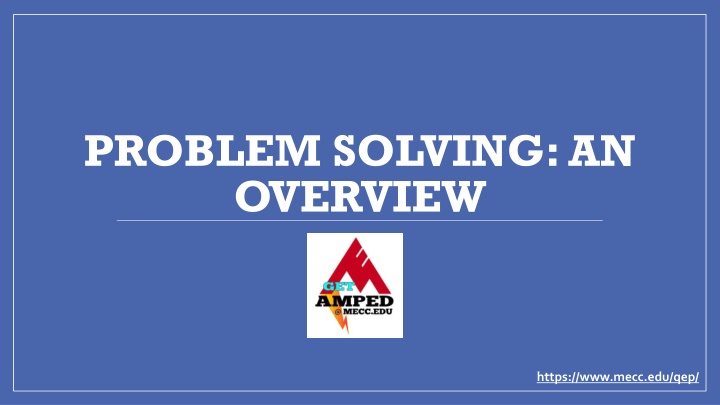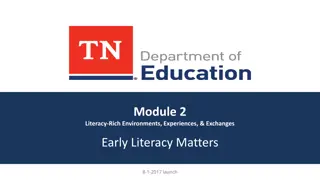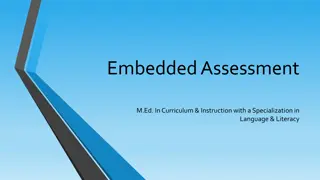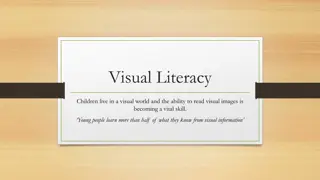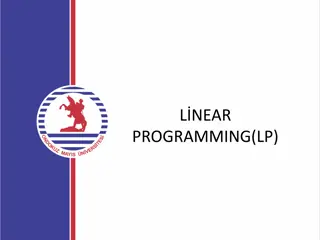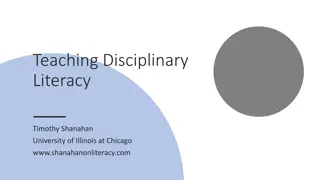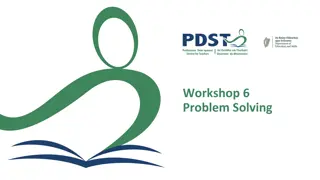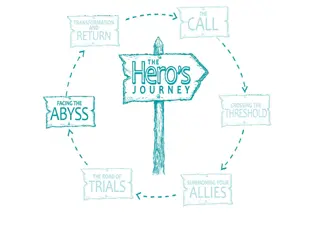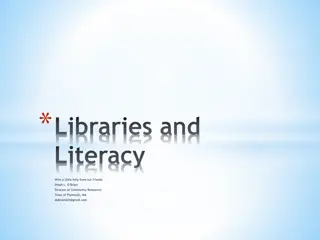Problem Solving: An Overview of Quantitative Literacy
Problem solving is the process of designing and implementing a strategy to achieve a goal. This presentation focuses on the key aspects of problem solving, such as defining the problem, determining root causes, and more, essential for students and employees alike.
Uploaded on Mar 17, 2025 | 2 Views
Download Presentation

Please find below an Image/Link to download the presentation.
The content on the website is provided AS IS for your information and personal use only. It may not be sold, licensed, or shared on other websites without obtaining consent from the author.If you encounter any issues during the download, it is possible that the publisher has removed the file from their server.
You are allowed to download the files provided on this website for personal or commercial use, subject to the condition that they are used lawfully. All files are the property of their respective owners.
The content on the website is provided AS IS for your information and personal use only. It may not be sold, licensed, or shared on other websites without obtaining consent from the author.
E N D
Presentation Transcript
PROBLEM SOLVING: AN OVERVIEW https://www.mecc.edu/qep/
Tying it all together The heart of quantitative literacy is real world problem solving the use of mathematics in everyday life, on the job, and as an intelligent citizen. Throughout your time at MECC, you have encountered Quantitative Literacy assignments. In doing that, you have learned that Quantitative Literacy (QL) is more than completing a basic calculation; instead, it is using data to make a decision. In this course, your program s capstone course, you will be completing a problem solving assignment that involves many of the QL skills you have learned thus far in your degree program. Your foundation in Quantitative Literacy will you to be effective problem solvers.
What is being asked of you? Your To-Do List: Carefully review this training on Problem Solving Complete the Problem Solving assignment in your capstone class to the best of your ability.
What is problem solving? Problem solving is the process of designing, evaluating and implementing a strategy to answer an open-ended question or achieve a desired goal. That being said, the aspects of problem solving being discussed in this presentation are pertinent to you both as a student and as an employee.
Problem Solving: Introduction Below are the six aspects of problem solving, which are further explained on the following slides.
Step One: Define the Problem Step One is about diagnosing the problem the context, background and symptoms of the issue. Once you have a clear grasp of what the problem is, you investigate the wider symptoms to discover the implications of the problem, who it affects, and how urgent/important it is to resolve the symptoms. You should demonstrate the ability to construct a clear and insightful problem statement with evidence of all relevant contextual factors.
Step Two: Determine the Root Cause(s) of the Problem Once the problem is defined, you begins to explore what has caused the problem. In this step, you may either simply brainstorm on paper or use tools such as the below chart: To demonstrate understanding of this, you will need to identify multiple approaches for solving the problem that apply within a specific context.
Step Three: Develop Alternative Solutions Analytical, creative problem solving is about creating a variety of solutions, not just one. Often the most obvious answer is not the most effective solution to the problem. To develop solutions, you will want to focus on: Proposing one or more solutions/hypotheses that indicates a deep comprehension of the problem. Solution/hypotheses are sensitive to contextual factors as well as all of the following: ethical, logical, and cultural dimensions of the problem.
Step Four: Select a Solution In the fourth step, you provideevaluation of solutions that is deep and elegant (for example, contains thorough and insightful explanation) and includes, deeply and thoroughly, all of the following: considers history of problem, reviews logic/reasoning, examines feasibility of solution, and weighs impacts of solution.
Step Five: Implement the Solution Once the solution has been chosen, you should consider: Who is going to implement this solution? Who else needs to be involved to implement the solution? What actions need to be taken before implementing the solution What actions need to be taken during the implementing the solution Why are these actions necessary? Therefore, you should implement the solution in a manner that addresses thoroughly and deeply multiple contextual factors of the problem.
Step Six: Evaluate the Outcome The project implementation now needs to be evaluated by the you to ensure their recommendations are followed. Was the proposed solution successful? What should have been done differently? What are some possible next steps? You should review results relative to the problem defined with thorough, specific considerations of need for further work.
Six Steps: Summary Step 1) Define the Problem Identify problems through problem formulation and questioning. The key is asking the right questions to discover root causes. Step 2) Determine the Root Cause During this process, assumptions are uncovered and underlying problems are further revealed. Also, this is an opportunity to collect and analyze data. Step 3) Develop Alternative Solutions Decisions are made within the group to determine the appropriate solution and process through creative selection. Step 4) Select a Solution Once the group has formed solutions and alternatives to the problem(s), they need to explore the pros and cons of each option through forecasting consequences. Step 5) Implement the Solution Develop an action plan to implement and execute the solution process. Step 6) Evaluate the Outcome This final stage requires an evaluation of the outcomes and results of the solution process. Ask questions such as: Did the option answer the questions we were working on? Did this process address the findings that came out of the assumptions? This process helps keep you on track, and enables a thorough investigation of the problem and solution search.
Whats Next? Complete the Problem Solving assignment to the best of your ability. If you have questions on a specific step, please ask your instructor.
